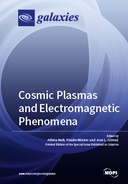Explore

Cosmic Plasmas and Electromagnetic Phenomena
0 Ungluers have
Faved this Work
Login to Fave
During the past few decades, plasma science has witnessed a great growth in laboratory studies, in simulations, and in space. Plasma is the most common phase of ordinary matter in the universe. It is a state in which ionized matter (even as low as 1%) becomes highly electrically conductive. As such, long-range electric and magnetic fields dominate its behavior. Cosmic plasmas are mostly associated with stars, supernovae, pulsars and neutron stars, quasars and active galaxies at the vicinities of black holes (i.e., their jets and accretion disks). Cosmic plasma phenomena can be studied with different methods, such as laboratory experiments, astrophysical observations, and theoretical/computational approaches (i.e., MHD, particle-in-cell simulations, etc.). They exhibit a multitude of complex magnetohydrodynamic behaviors, acceleration, radiation, turbulence, and various instability phenomena. This Special Issue addresses the growing need of the plasma science principles in astrophysics and presents our current understanding of the physics of astrophysical plasmas, their electromagnetic behaviors and properties (e.g., shocks, waves, turbulence, instabilities, collimation, acceleration and radiation), both microscopically and macroscopically. This Special Issue provides a series of state-of-the-art reviews from international experts in the field of cosmic plasmas and electromagnetic phenomena using theoretical approaches, astrophysical observations, laboratory experiments, and state-of-the-art simulation studies.
This book is included in DOAB.
Why read this book? Have your say.
You must be logged in to comment.
Rights Information
Are you the author or publisher of this work? If so, you can claim it as yours by registering as an Unglue.it rights holder.Downloads
This work has been downloaded 141 times via unglue.it ebook links.
- 126 - pdf (CC BY-NC-ND) at Unglue.it.
Keywords
- 26Al
- accreting black holes
- accretion discs–jets
- Accretion Disks
- Active galactic nuclei
- active galaxies
- AGN
- black holes
- blazars
- cosmic ray knee and ankle
- Cosmic Rays
- effective lifetime
- galaxies: active
- gamma-ray bursts
- global jets
- GRMHD
- helical magnetic fields
- high energy astrophysics
- high-power laser systems
- jets
- kink-like instability
- laser plasma
- laser-induced nuclear reactions
- Magnetic Fields
- magneto-hydrodynamics
- massive star supernovae
- MHD winds
- MHD–accretion
- multi-wavelength astronomy
- mushroom instability
- muti-messenger astronomy
- Neutrino astrophysics
- Nuclear astrophysics
- Numerical methods
- Numerical Relativity
- particle-in-cell simulations
- Plasma Physics
- Polarization
- radiation mechanism: non-thermal
- Radio interferometry
- recollimation shocks
- relativistic astrophysics
- relativistic jets
- TBD
- the Weibel instability
- X-ray binaries
Links
DOI: 10.3390/books978-3-03921-466-2Editions


